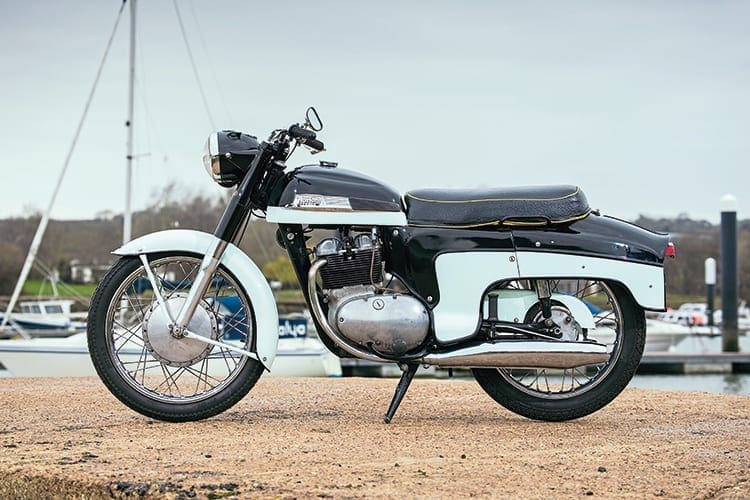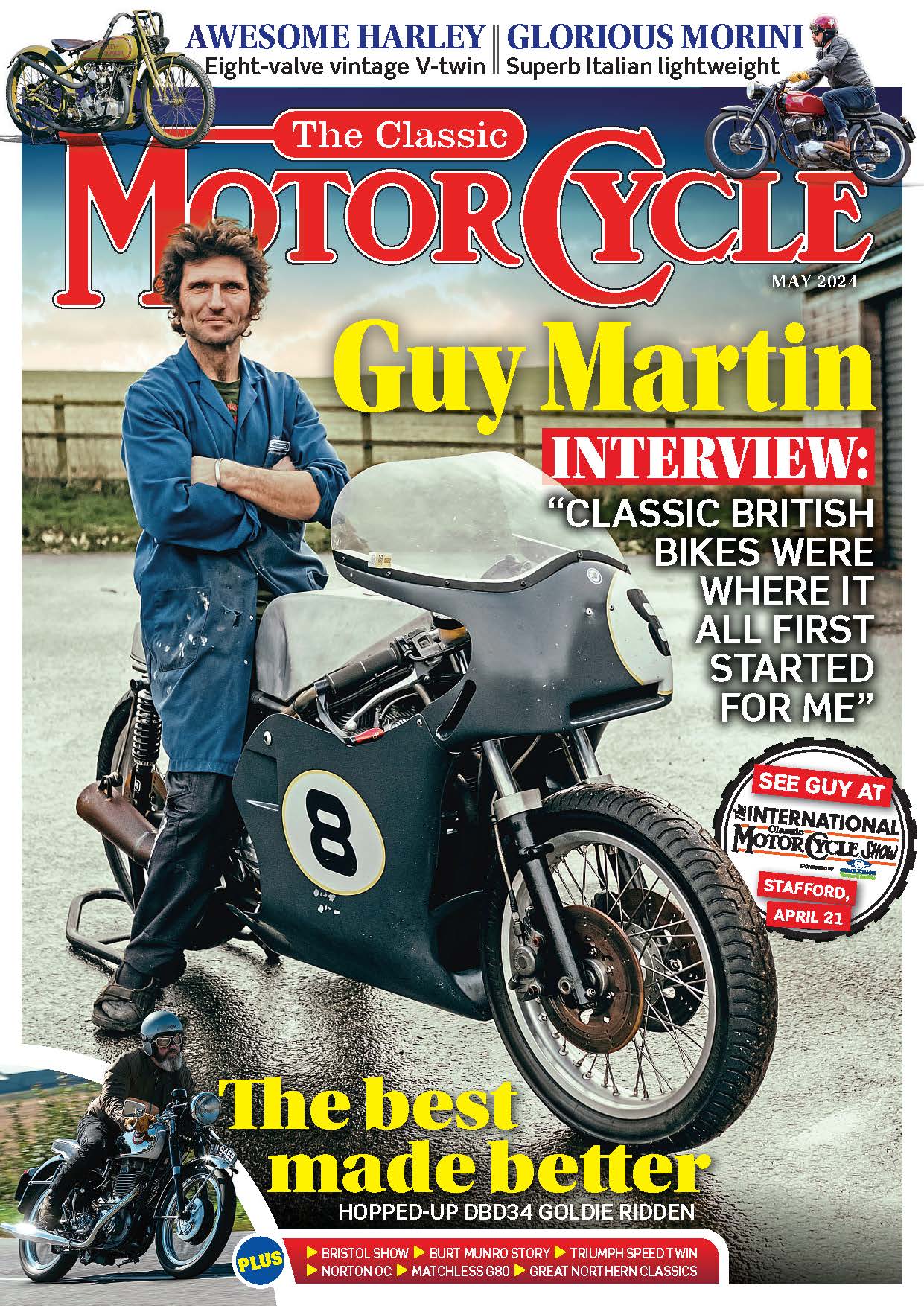
This full-dress, flawed but fun 350cc light twin was your tester’s first motorcycle – a very long time ago!
Words: STEVE WILSON Photographs: JONATHAN FLEETWOOD
Enjoy more Classic MotorCycle reading in the monthly magazine.
Click here to subscribe & save.
If I had one distinction during my student life at Oxford, it was in 1963, persuading the uni film society to show the still-banned 1954 movie ‘The Wild One’ – which as a club they could legally do.
It wasn’t a great film, Hollywood-compromised in production, but Brando gave a great, mesmerising performance, frequently astride his personal 1950 Triumph Thunderbird. I already had the Ray-Ban Wayfarer shades and a Lewis Leathers Bronx black leather jacket, but a fellow college motorcyclist, Mike Sewell, (skilled, fast, and mechanically capable), had inspired me with his Wideline Dominator 99 to consider only a Norton for my first motorcycle. I’d passed my test on a scooter, and then ridden it to Greece and back.
Mild One?
Mike thought that the Navigator 350cc light twin, introduced for 1961, would do me well for a first bike. It was reported to have ironed out the problems (though it kept a few of its own) of its disastrous high-revving 1958-on 250cc Jubilee predecessor; which had included, courtesy of a purchasing office glitch, cracking cranks for the first 2000 produced.
The Navigator replaced the crank with a forged steel one, again running on main bearings with the same dimensions, though not identical to, those on the Dominators. The 250’s flimsy Francis-Barnett forks and six-inch front brake were changed to state-of-
the-art Roadholder forks and the eight-inch sls stopper off the big twins, with Girling units at the rear. The Francis-Barnett-based frame had been stiffened, and Doug Hele had selected a steeper steering-head angle, sharpening the handling and leaving the wheelbase at an ultra-compact 51.5 inches. This
was a Proper Norton.
That didn’t stop me getting Temples, the less intimidating motorcycle dealers compared to Stan Hailwood’s Kings of Oxford, to lengthen the cables and fit cow horn handlebars on my Navigator, aping the Flanders bars on Brando’s T’bird. The trouble was, the rest of the styling was not exactly West Coast Kool, since the only Navigator I had been able to find at Pride and Clarke had been a second-hand 1961 De Luxe variant, with two-tone blue and dove grey panelling. As well as adding 10lbs weight to the unfaired Standard version, the panelling had been made by Clarendon Pressings, a subsidiary of Francis-Barnett – “And it looked like it!” as Bob Currie later wrote. Terminally uncool, and I had to endure more than one jibe about ‘a big scooter.’
All Wight now
Fast-forward (gulp) 56 years, and I was on the Isle of Wight, looking at another 1961 Navigator De Luxe, its black and dove grey finish considerably smarter than the originals’. Bracebridge Street, Birmingham, where the light twins were produced until the early 1963 move to AMC Central at Plumstead, had been building desperately down to a price. I remember scuff-prone paint, including the impractical pale-coloured centrestand, and chrome peeling off like silver sticky tape. At £229-15s in late 1960, they did undercut Triumph’s 350 3TA/21 by a fiver, but sales were to be stagnant, with both the UK and European markets falling off a cliff from 1960 on, as cheap cars came on stream.
M’learned Other Island friend Ken Powell had spotted this smart 350 for sale at a Sammy Miller autojumble, and ever one for the unusual, bought it from an owner who’d had it for four years and only done the paintwork and some cosmetics, to a good standard, though the yellow piping on the black dualseat was, I believe, somebody’s fancy; my seat had a pale grey top (another impracticality) with white piping. Ken had a bad get-off on another machine shortly after, and sold the Norton, but then hankered after it and bought it back, though he hasn’t yet done many miles on it; the 37,000-odd miles on the clock feels credible.
Another bonus with this machine is that it has been converted to 12 volts and fitted with Boyer electronic ignition, the system itself the fruit of research done by a group of light twin ultra-enthusiasts in Malmesbury. This does away with a persistent bug-bear for me and others back in the 1960s – the way that the 350 with its twin contact breaker points, unfamiliar to many then, kept going out of tune. The six-volt electrics were one of the Navigator’s three major problem areas. Again down to a price, a Wipac alternator and coil system, and switches, had been chosen. Wipac’s auto-advance units wore quickly, and after about 5000 miles they became very hard to time.
And correct ignition timing was critical, as the engine was very sensitive to excess spark advance, which led to rough running and burnt pistons. The split-skirt pistons themselves could be fragile, with the split too close to the gudgeon pin, and tending to break up across their top ends. Also the gudgeon pin circlip was a flat stamping, which could do damage if its eye broke off. So the Norton was not without its mechanical problems too.
Towards the end of a 1000-plus mile trip through France, Spain and Italy in 1963, my own alternator began to give out. A Lucas agent in Genoa turned up his nose at Wipac (though today Lucas rotors have been successfully substituted) and I only got home by expensively putting self and Norton on a train from Nice to Paris, and with the money gone, limping the 200-odd miles from there to the ferry on just coffee and petrol fumes (the Navigator’s overall student-friendly 70mpg meant that its three gallon tank gave a useful range).
Ken, a student of the odd, thinks that with so much tinware junked over the years, today the panelling is interesting. I see what he means, but some scars run deep! Sad to say, Norton under Bert Hopwood had been following Edward Turner’s lead with his Triumph unit-construction, alternator-electrics C-range 350 from 1957, and then 500, twins, the 3TA and 5TA, all complete with rather more curvy panelling. Ironically Norton were following Turner down a dead end, as despite the aspiration to imitate the success of ‘clean’ scooters with their concealed mechanics, the motorcyclists of America, Triumph’s major market, would have none of it, and threw out panelling from the get-go.
From early 1963 the 400cc Norton Electra light twin, with its electric foot as demanded by AMC’s US importer Joe Berliner, went out ‘naked’ from the start, and the other De Luxe version Norton light twins were dropped during that year. Why hadn’t I just stripped off the Navigator’s tin? It was, I was told, not a simple job. The De Luxe and Standard frames were slightly different to each other, with their battery tray and toolboxes in different locations, so it wouldn’t have been just a matter of bolting on a rear mudguard. And bottom line, it would have cost £25, so I had to forget it. That meant no secure way of carrying luggage, and on a dusty, bumpy road in northern Spain, a duffel-bag of prized possessions broke free and went AWOL for good.
Read more in the November issue of The Classic MotorCycle – on sale now!
Advert
 Enjoy more The Classic MotorCycle reading in the monthly magazine. Click here to subscribe.
Enjoy more The Classic MotorCycle reading in the monthly magazine. Click here to subscribe.











